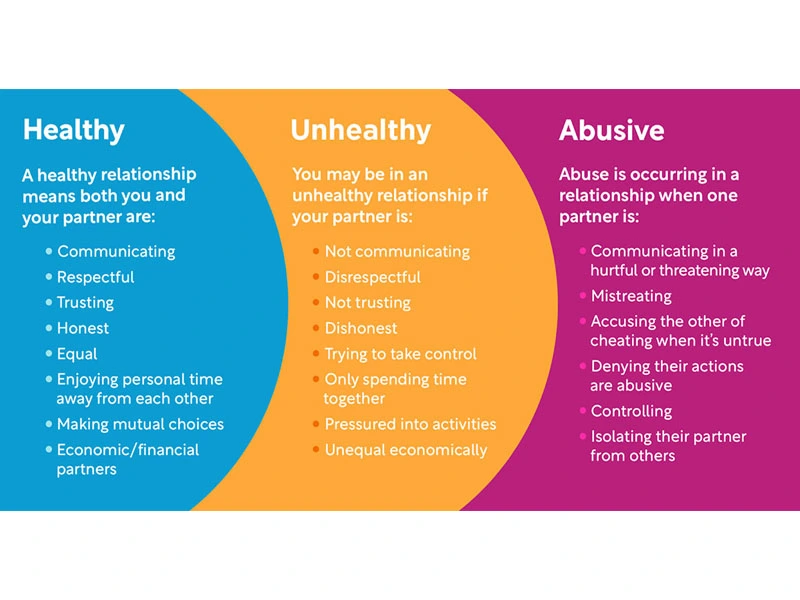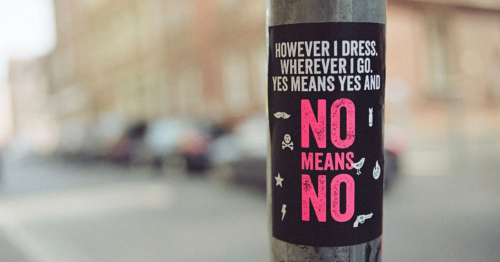
Table of Contents
Understanding Intimate Partner Violence for Teens

Written By: Alex Bachert, MPH
May 12, 2022
7 min.
Violence and psychological aggression have no place in a relationship. We outline how to identify an unhealthy relationship and provide resources to leave one.
Learn more about our Clinical Review Process
Table of Contents
First relationships are full of surprises. Everything is fresh, everything is exciting, and part of the fun is seeing what each new day and phase brings.
Dating as a teenager or young adult can also be a bit stressful, though. You might not have much to compare your relationship to—other than observing your parents or what you see on social media—so it can be tough to determine if something is “normal” or not.
A little relationship advice from Charlie Health? Each partnership has its own unique dynamic, but dating violence never has a place in a respectful relationship.
Dating violence is a type of intimate partner violence that can occur in person, online, or via other forms of technology. When you hear the term “violence,” you might automatically think of physical violence, but there are actually three additional ways that a person’s partner can influence their health, happiness, and overall quality of life.
The four main types of dating violence
Physical violence
When someone uses physical force to hurt or attempt to hurt a partner.
Sexual violence
Forcing or attempting to force a partner to engage in a sex act when they don’t consent, are unable to consent, or refuse. This also includes non-physical sexual behaviors like sharing sexual messages or photos from a partner without their consent.
Psychological abuse
Verbal and non-verbal communication with the intent to emotionally harm and exert control over a partner.
Stalking
A pattern of repeated and unwanted attention by a current or former partner that causes safety concerns for you or your loved ones.
Millions of high school students experience physical abuse from a dating partner each year, yet only 33% of teens in an abusive relationship ever tell anyone about the abuse. Today, we’re here to offer some real advice on signs of an unhealthy relationship, how it affects your mental health, and how to leave a partnership that has grown toxic.
Join the Charlie Health Library
Get mental health updates, research, insights, and resources directly to your inbox.
You can unsubscribe anytime.
Healthy teen relationships vs. unhealthy teen relationships
Healthy relationships are built upon mutual respect, trust, and honesty. You might not always agree on what movie to watch or maybe you sometimes wish your partner would get new friends, but you both see the importance of communication and compromise.
Unhealthy relationships, on the other hand, are defined by disrespect and control. There's no one specific behavior that causes a relationship to be categorized as abusive or unhealthy, but there are certain signs that should raise red flags.

Signs of an abusive relationship
If you’re wondering if you or someone you know is in a toxic relationship, take a look at this list of unhealthy or abusive behaviors.
- Extreme jealousy or insecurity
- Invasions of privacy or constantly checking in to see what you're doing
- Bullying, threatening, or physical violence
- Preventing you from spending time with other people
- Pressuring you into unwanted sexual activity
- Explosive temper, unusual mood swings, or unexpected bouts of anger
- Blaming you for problems in the relationship without taking any responsibility
- Falsely accusing you of things
How common is teen dating violence and abuse?
Findings from the Centers for Disease Control and Prevention's 2019 Youth Risk Behavior Survey show that dating violence is common (too common) among teenagers in the U.S. Approximately one in 12 high schoolers experienced physical dating violence, and one in 12 experienced sexual dating violence in the last year, according to the report.
Some studies show that it’s most often females who are victims of teen dating violence, but others have found that females and males show similar rates of aggression and victimization. One thing that the research agrees on, however, is that it’s primarily females who suffer from severe violence in relationships. Females are more likely than males to be seriously injured or suffer sexual abuse due to dating violence.
Teen Dating Violence in the LGBTQIA+ Community
Individuals who are lesbian, gay, bisexual, transgender, or queer, intersex, asexual, or agender may experience higher rates of physical and sexual dating violence compared to students who identify as heterosexual. Research also suggests that transgender individuals experience even more intimate partner violence than non-trans individuals.
Do you need more support with
your mental health?
Charlie Health can help.
According to a study of nearly 4,000 7th-12th graders in New York, Pennsylvania, and New Jersey:
- 43% of LGBTQIA+ youth reported being victims of physical dating violence versus 29 percent of non-LGBTQIA+youth youth
- 59% of LGBTQIA+ youth reported emotional abuse from a dating partner versus 46 percent of non-LGBTQIA+ youth
- 37% of LGBTQIA+ youth reported cyber or phone abuse and harassment versus 26 percent of non-LGBTQIA+ youth
- 23% of LGBTQIA+ youth reported sexual coercion versus 12 percent of non-LGBTQIA+youth
What are the consequences of an unhealthy relationship?
Being in an abusive relationship can have some serious consequences, both in the short term and down the line. Teens who experience dating violence are more likely to suffer from:
- Depression and anxiety
- Tobacco, marijuana, and alcohol misuse
- Suicidal thoughts
Having a violent partner during adolescence has also been linked to poor academic performance, negative body image, and antisocial behaviors, like theft, lying, and bullying.
In some cases, abusive teen relationships can even lead to death—especially for females. A study from 2019 found that teen dating violence poses a risk of homicide for adolescent girls, especially related to a breakup or jealousy and when partners have access to firearms.
How to leave an unhealthy relationship
If you think that you or a loved one are in an abusive relationship, the time to seek help is now. Research shows that abusive behaviors in unhealthy relationships are more likely to increase over time, and abuse tends to worsen as the relationship progresses.
Today, only about one-third of teens who are in an unhealthy or abusive relationship confide in someone. The reasons that teens stay in these relationships vary, but some of the most common are that they're ashamed of the situation, intimidated into staying in the relationship, they lack the resources to leave, or they’re not sure where to seek help. This goes without saying, but we’re here to remind you that the situation is not your fault. Being on the receiving end of jealousy, threats, and anger can influence your decision-making skills, and it’s completely understandable to be concerned about how your partner might react.
The team at Charlie Health wants you to know two more things
1) Choosing to leave an unhealthy relationship is extremely brave
2) You’re not doing it alone.
Below are several resources to consider for help and guidance as you take the first steps to leave a toxic partnership.
- Create a safety plan so that you’re prepared for anything. As described by the organization Love Is Respect, a safety plan is designed to prioritize your safety during an abusive relationship, as you prepare to end it, or after you leave an abusive situation. These practical plans help you to explain your situation to others and include various resources suited to your individual circumstances. Learn how to create your own safety plan based on your daily routine, technology habits, and emotions.
- Confide in a trusted family member, friend, teacher, or mentor for support and guidance.
- Spend more time with other people you care about (and who care about you back). It can be tough to talk about relationship abuse, so staying in touch with friends and family members is crucial for emotional support.
- Connect with a counselor or therapist for professional mental health support. You can find online therapy programs for your specific needs—LGBTQIA+-centered group sessions, family therapy, and individual talk therapy—and receive treatment from the comfort of your own home.
- Consult a Helpline for immediate support.
- Love Is Respect Helpline: 1-866-331-9474
- National Domestic Violence Hotline: 1-800-799-7233
- National Suicide Prevention Lifeline: 988 or text the Crisis Text Line: HOME at 741741.
- Visit the NO MORE Directory to find more resources near you.
Turn to Charlie Health for help
Everyone, regardless of age, gender, sexual orientation, or gender expression, deserves a healthy relationship in which they're treated with respect.
At Charlie Health, we offer virtual mental health treatment for adolescents, young adults, and families experiencing mental health crises. Our intensive outpatient program (IOP) combines trauma-informed therapy, supported groups, and family therapy to help you build resilience and start healing.
Whether you’ve just left an unhealthy relationship or you’re working toward it, our compassionate, experienced mental health professionals will provide a safe place for you to heal and grow so you can become the best version of yourself. Get started today.
References
https://www.cdc.gov/intimate-partner-violence/about/about-teen-dating-violence.html
https://www.loveisrespect.org/pdf/Dating_Abuse_Statistics.pdf
https://www.loveisrespect.org/everyone-deserves-a-healthy-relationship/relationship-spectrum/
https://www.teendvmonth.org/resources/signs-teen-dating-violence/
https://www.cdc.gov/violenceprevention/intimatepartnerviolence/teendatingviolence/fastfact.html
https://pubmed.ncbi.nlm.nih.gov/18407042/
https://youth.gov/youth-topics/teen-dating-violence/gender#_ftn6
https://avp.org/wp-content/uploads/2017/04/2015_ncavp_lgbtqipvreport.pdf
https://pubmed.ncbi.nlm.nih.gov/23230075/
https://www.ncbi.nlm.nih.gov/pmc/articles/PMC5521998/
https://www.loveisrespect.org/personal-safety/create-a-safety-plan/





